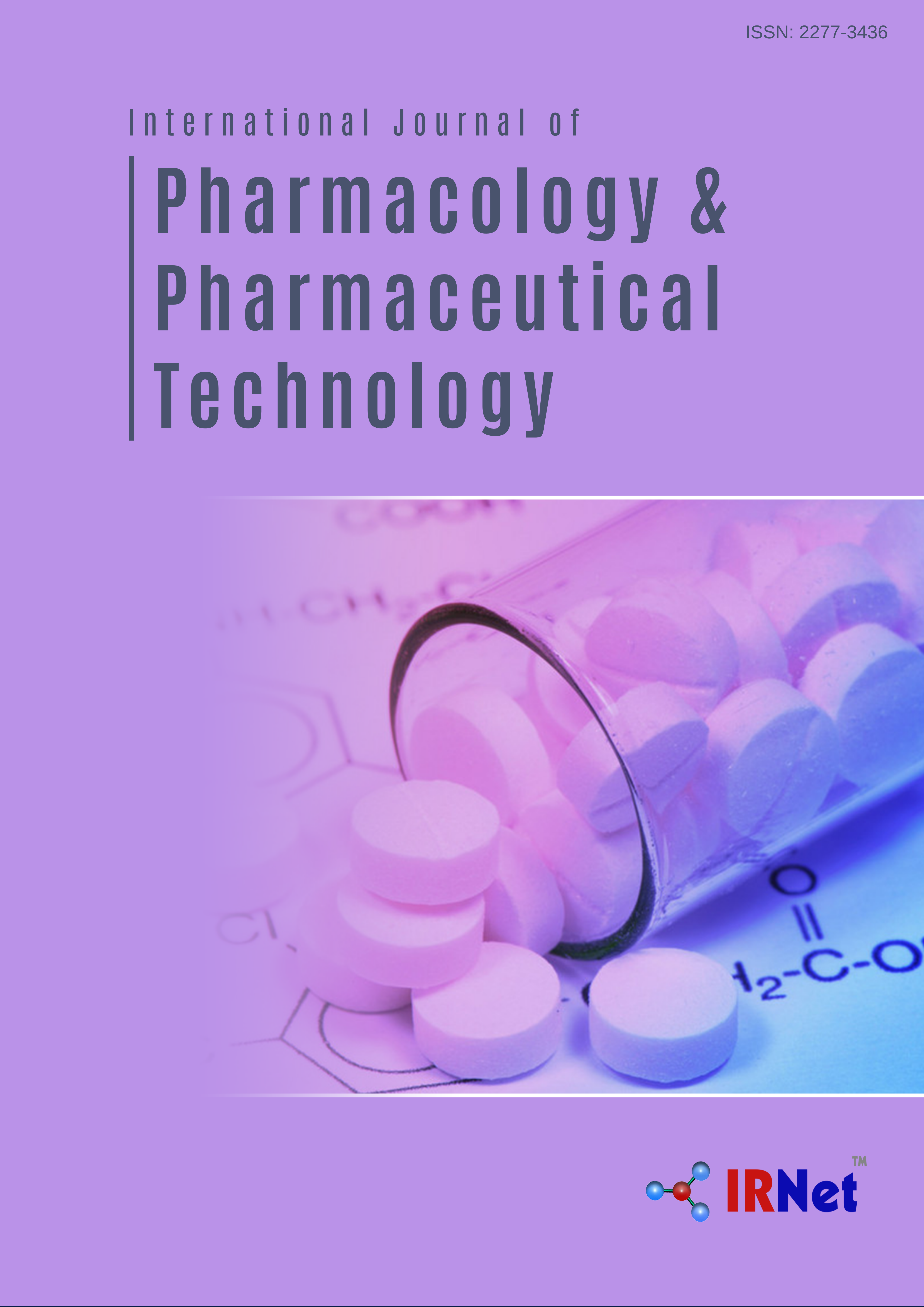International Journal of Pharmacology and Pharmaceutical Technology IJPPT
ISSN: 2277-3436

Abstracting and Indexing


IJPPT
pH Responsive Polymeric Nanoparticles for Oral Insulin Delivery pH Responsive Polymeric Nanoparticles for Oral Insulin Delivery
Charu Tyagi
V.S.P.Govt.(P.G.) College, C.C.S. University, Meerut-250004, U.P., India
Lomas Tomar
Centre for Biomedical Engineering, Indian Institute of Technology, Delhi 110016, India
Pradeep Kumar
University of the Witwatersrand, Faculty of Health Sciences, Department of Pharmacy and Pharmacology
Yahya E. Choonara
University of the Witwatersrand, Faculty of Health Sciences, Department of Pharmacy and Pharmacology
Lisa Du Toit
University of the Witwatersrand, Faculty of Health Sciences, Department of Pharmacy and Pharmacology
Harpal Singh
Centre for Biomedical Engineering, Indian Institute of Technology, Delhi 110016, India
Viness Pillay
University of the Witwatersrand, Faculty of Health Sciences, Department of Pharmacy and Pharmacology
Abstract
Gelatin-eudragit L100 nanoparticles of wet size range 170-563nm were prepared by two step dissolvation method and the effect of different concentrations of eudragit L100 and emulsifying agent - sodium lauryl sulphate (SLS) - on the particle size were studied. Synthesized nanoparticles were characterized by attenuated total reflectance-fourier transform infrared spectroscopy (ATR FTIR) and the mean size distribution. Insulin loading was done at a pH 7.4 and the in vitro insulin release studies of nanoparticles were carried out by simulating gastrointestinal tract condition which showed the minimal insulin release at pH 2.5 (20% in 90min) while appreciable release (40% in first 30min) at pH of 7.4. This pH responsive release pattern of the synthesized nanoparticles confers on the insulin protection from proteolytic degradation in acidic environment of stomach and upper intestinal part while enhancing bioavailability in the later part of intestine.
Recommended Citation
[1] REFERENCES W. T. Cefalu, “Concepts, strategies, and feasibility of noninvasive insulin delivery,” Diabetes Care, Jan. 2004, vol. 27, 239–46. [2] [3] [4] [5] [6] [7] [8] R. I. Mahato, A. S. Narang , L. Thoma and D. D. Miller, “Emerging trends in oral delivery of peptide and protein drugs,” Crit. Rev. Ther. Drug Carrier Syst., vol. 20, 2003(2-3), pp. 153-214. of J. H. Hamman, G. M. Enslin and A. F. Kotzé, “Oral delivery peptide drugs: barriers and developments,” BioDrugs, vol. 19, 2005(3), pp. 165-77. S. V. Sastry, J. R. Nyshadham and J. A. Fix, “Recent technological advances in oral drug delivery - a review,” Pharm. Sci. Technol. Today, vol. 3, Apr. 2000, pp. 138-145. M. Mesiha, F. Plakogiannis and S. Vejosoth, “Enhanced oral absorption of insulin from desolvated fatty acid-sodium glycocholate emulsions.” Int. J. Pharm. vol. 111, 1994, pp. 213 216. I. Morishita, M. Morishita, K. Takayama, Y. Machida and T. Nagai, “Hypoglycemic effect of novel oral microspheres of insulin with protease inhibitors in normal and diabetic rats,” Int. J. Pharm. vol. 78, 1992, pp. 9-16. T. Kimura, K. Sato, K. Sugimoto, R. Tao, T. Murakami, Y. Kurosaki and T. Nakayama, “Oral administration of insulin as poly(vinyl alcohol)-gel spheres in diabetic rats,” Biol. Pharm. Bull, vol. 19, Jun. 1996, pp. 897-900. H. Takeuchi, H. Yamamoto, T. Niwa, T. Hino and Y. Kawashima, “Enteral absorption of insulin inliposomes,” Pharm. Res., vol. 13, Jun. 1996, pp. 896-901. [9] Z. Ahmad, R. Pandey, S. Sharma and G. K. Khuller, “Alginate nanoparticles as antituberculosis drug carriers: formulation development, pharmacokinetics and therapeutic potential,” Indian J. Chest Dis. Allied Sci., vol. 48, Jul-Sep. 2006, pp. 171-176. [10] J. K. Suh and H. W. Matthew, “Application of chitosan-based polysaccharide biomaterials in cartilage tissue engineering: a review,” Biomaterials, vol. 21, Dec. 2000, pp. 2589-2598. [11] R. Mehvar, “Dextrans for targeted and sustained delivery of therapeutic and imaging agents,” J. Control Release, vol. 69, Oct. 2000, pp. 1-25. [12] K. L. Goa and P. Benfield, “Hyaluronic acid: A review of its pharmacology and use as a surgical aid in ophthalmology, and its therapeutic potential in joint disease and wound healing,” Drugs, vol. 47, Mar. 1994, pp. 536-66. [13] R. Schrieber and H. Garies, Gelatin Handbook: Theory and Industrial Practice, Wiley-VCH: Weinheim, Germany, 2007 [14] J. Vandervoort and A. Ludwig, “Preparation and evaluation of drug-loaded gelatin nanoparticles for topical ophthalmic use,” Eur. J. Pharm. Biopharm., vol. 57, Mar. 2004, pp. 251-61. [15] G. Kaul and M. Amiji, “Long-circulating poly(ethylene glycol)-modified gelatin nanoparticles for intracellular delivery,” Pharm. Res., vol. 19, Jul. 2002, pp. 1061-1067. [16] C. Weber, S. Reiss and K. Langer, “Preparation of surface modified protein nanoparticles by introduction of sulfhydryl groups,” Int. J. Pharm., vol. 211, Dec. 2000, pp. 67-78. [17] T. Chen, H. D. Embree, L. Q. Wu and G. F. Payne, “In vitro protein-polysaccharide conjugation: tyrosinase-catalyzed conjugation of gelatin and chitosan,” Biopolymers, vol. 64, Sep. 2002, pp. 292-302. [18] J. Ma J, H. Cao and Y. Li, “Synthesis and characterization of poly(DL-lactide)-grafted gelatins as bioabsorbable amphiphilic polymers,” J. Biomater. Sci. Polym. Ed., vol. 13, 2002, pp. 67-80. [19] A. J. Shukla, Handbook of Pharmaceutical Excipients, American Pharmaceutical Association, Pharmaceutical Press, Washington DC, 1994. [20] M. Jahanshahi, M. H. Sanati, S. Hajizadeh and Z. Babaei, “Gelatin nanoparticle fabrication and optimization of the particle size,” Physica. Status Solidi A, vol. 205, Dec. 2008. pp. 2898–2902. [21] L. K. Tomar, C. Tyagi, S. S. Lahiri and H. Singh, “Poly(PEGDMA-MAA) copolymeric micro and nanoparticles for oral insulin delivery,” Polym. Adv. Technol., 2011, pp. 1760–1767 [22] S. Goswami, J. Bajpai and A.K. Bajpai, “Designing gelatin nanocarriers as a swellable Ssstem for controlled release of insulin: an in-vitro kinetic study,” J. Macromol. Sci. Part A: Pure and Applied Chemistry, vol. 47, 2010, pp. 119–130. [23] Specification and Test Method for Eudragit L100, Evonik Ind., 2007, www.pharma-polymers.com